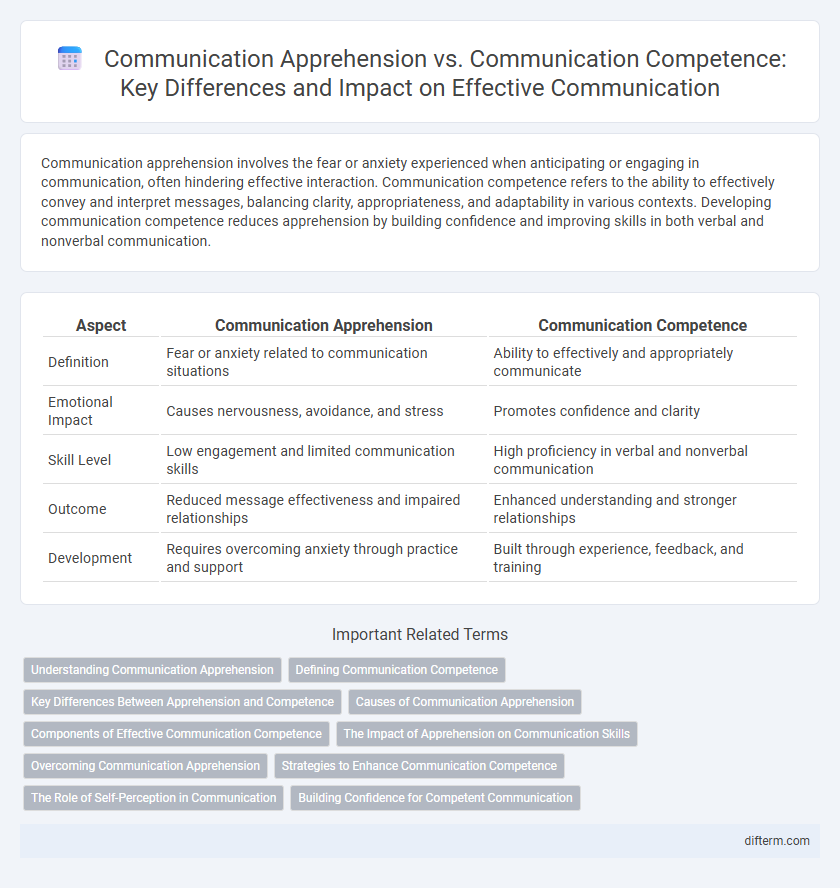Communication apprehension involves the fear or anxiety experienced when anticipating or engaging in communication, often hindering effective interaction. Communication competence refers to the ability to effectively convey and interpret messages, balancing clarity, appropriateness, and adaptability in various contexts. Developing communication competence reduces apprehension by building confidence and improving skills in both verbal and nonverbal communication.
Table of Comparison
| Aspect | Communication Apprehension | Communication Competence |
|---|---|---|
| Definition | Fear or anxiety related to communication situations | Ability to effectively and appropriately communicate |
| Emotional Impact | Causes nervousness, avoidance, and stress | Promotes confidence and clarity |
| Skill Level | Low engagement and limited communication skills | High proficiency in verbal and nonverbal communication |
| Outcome | Reduced message effectiveness and impaired relationships | Enhanced understanding and stronger relationships |
| Development | Requires overcoming anxiety through practice and support | Built through experience, feedback, and training |
Understanding Communication Apprehension
Communication apprehension refers to the fear or anxiety individuals experience when anticipating or engaging in communication with others, impacting their ability to express ideas effectively. Understanding communication apprehension involves recognizing its psychological roots, such as fear of negative evaluation or past negative experiences, which can inhibit verbal and nonverbal interactions. Developing strategies to reduce this anxiety, including relaxation techniques and gradual exposure to communication situations, enhances communication competence and improves overall interpersonal effectiveness.
Defining Communication Competence
Communication competence refers to the ability to effectively convey and interpret messages in various contexts while adapting to social norms and audience expectations. It encompasses skills such as clarity, listening, empathy, and appropriate nonverbal behavior, which reduce communication apprehension and enhance interpersonal interactions. Developing communication competence leads to increased confidence, improved relationships, and successful information exchange across diverse communication settings.
Key Differences Between Apprehension and Competence
Communication apprehension refers to the fear or anxiety associated with oral communication, often leading to avoidance of interactions, whereas communication competence involves the ability to effectively and appropriately convey messages in various contexts. Apprehension is measured by psychological and emotional reactions to speaking situations, while competence is evaluated based on clarity, appropriateness, and effectiveness in communication skills. Understanding these differences is crucial for targeted interventions to reduce fear and enhance overall communication performance.
Causes of Communication Apprehension
Communication apprehension often stems from factors such as fear of negative evaluation, lack of experience, and low self-confidence in speaking situations. Psychological causes include anxiety related to judgment and fear of rejection, while situational causes involve unfamiliar audiences or high-stakes environments. Understanding these root causes is crucial for developing strategies to enhance communication competence and reduce apprehension effectively.
Components of Effective Communication Competence
Effective communication competence encompasses key components such as message clarity, active listening, and adaptability to diverse audiences, which help reduce communication apprehension. Mastering these elements enables individuals to convey ideas confidently and interpret feedback accurately, enhancing interpersonal interactions. Developing emotional intelligence and nonverbal sensitivity further improves communication effectiveness by fostering mutual understanding and trust.
The Impact of Apprehension on Communication Skills
Communication apprehension significantly hinders the development of effective communication skills by increasing anxiety and reducing confidence during interactions. Individuals with high apprehension often struggle with message clarity, nonverbal expression, and responsiveness, leading to misunderstandings and diminished relational outcomes. Enhancing communication competence requires targeted strategies to manage apprehension, fostering improved verbal and nonverbal communication abilities.
Overcoming Communication Apprehension
Overcoming communication apprehension involves building communication competence through practice and exposure to various speaking situations. Techniques such as systematic desensitization, cognitive restructuring, and skill training enhance confidence and reduce anxiety. Developing effective verbal and nonverbal communication skills contributes significantly to minimizing communication apprehension and improving overall interaction competence.
Strategies to Enhance Communication Competence
Effective strategies to enhance communication competence include active listening, practicing empathy, and developing clear message organization. Utilizing feedback mechanisms and engaging in role-playing scenarios also improve confidence and adaptability in diverse communication settings. Consistent self-assessment and targeted skill-building exercises reduce communication apprehension and foster more effective interpersonal interactions.
The Role of Self-Perception in Communication
Self-perception significantly influences communication apprehension and competence by shaping individuals' confidence in their ability to convey messages effectively. High self-perception enhances communication competence through increased willingness to engage in conversations, while low self-perception correlates with heightened communication apprehension and avoidance behaviors. Improving self-perception through positive feedback and skill development fosters stronger communication outcomes and reduces anxiety in interpersonal interactions.
Building Confidence for Competent Communication
Building confidence for competent communication involves reducing communication apprehension by practicing skills such as active listening, clear articulation, and effective nonverbal cues. Developing these competencies enhances self-assurance and fosters more successful interactions in both personal and professional contexts. Consistent exposure to varied communication situations strengthens abilities and diminishes anxiety, creating a positive feedback loop for continuous improvement.
communication apprehension vs communication competence Infographic

 difterm.com
difterm.com